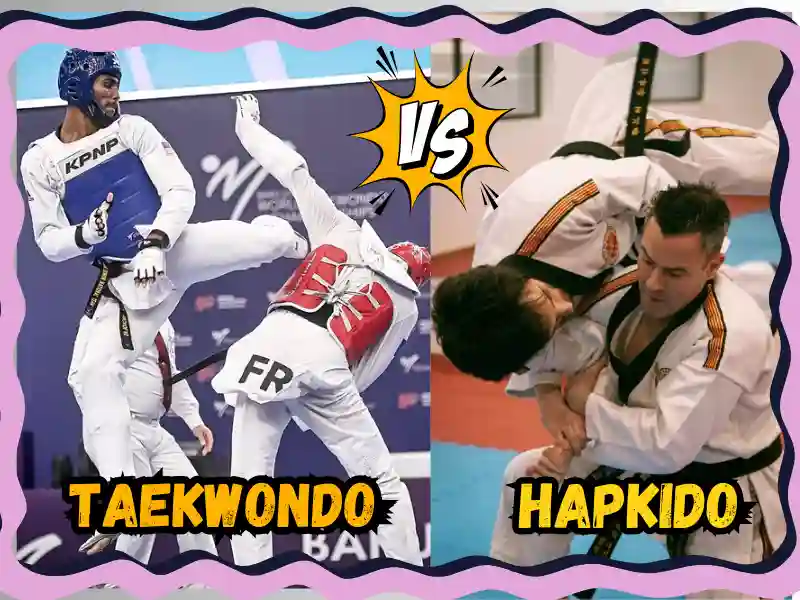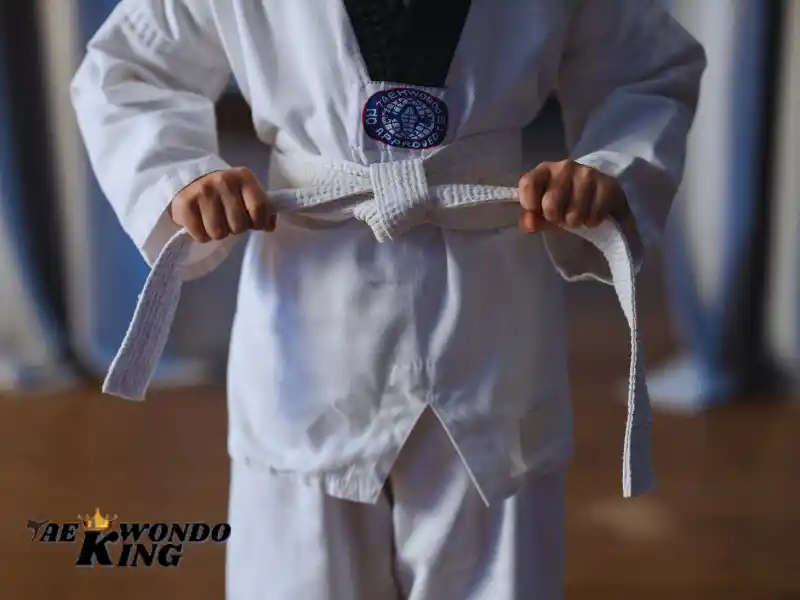
As a Taekwondo national and international player, coach, 3rd Dan black belt holder, and national referee, I have had the privilege of immersing myself deeply in the martial arts world. Among the myriad martial arts that have gained global recognition, Hapkido and Taekwondo stand out for their rich histories, philosophical underpinnings, and diverse techniques. While both (Hapkido vs Taekwondo) are Korean martial arts, they exhibit distinctive characteristics and philosophies.
In this article, I will delve into the key differences and similarities between Hapkido and Taekwondo, offering insights into their unique attributes and common ground.
Historical Background: Hapkido vs Taekwondo
History of Taekwondo and Hapkido
Hapkido:
Hapkido, meaning “the way of harmonious energy,” was developed in the mid-20th century by Choi Yong-Sool, who combined his knowledge of Daito-ryu Aiki-jujutsu with traditional Korean martial arts. It focuses on the principles of non-resistance, circular motion, and the utilization of an opponent’s energy to execute techniques.
Taekwondo:
Taekwondo, translating to “the way of the foot and the hand,” has roots tracing back to ancient Korean martial arts such as Taekkyeon and Subak. Modern Taekwondo was formalized in the 1940s and 1950s by Korean martial artists, with General Choi Hong Hi being a pivotal figure in its development. Taekwondo emphasizes high, fast kicks and dynamic hand techniques.
Philosophical Underpinnings
Hapkido Philosophy:
Hapkido is grounded in the principles of harmony, adaptability, and efficiency. Practitioners aim to blend with an opponent’s force rather than confronting it directly. The art teaches flexibility in both physical and mental approaches to conflict, emphasizing the importance of yielding and redirecting energy.
Taekwondo Philosophy:
Taekwondo’s philosophy is encapsulated in its five tenets: Courtesy, Integrity, Perseverance, Self-Control, and Indomitable Spirit. These tenets guide practitioners not only in their martial arts training but also in their daily lives, promoting ethical behavior, respect, and self-discipline.
Techniques and Training
Hapkido Techniques:
Hapkido is renowned for its extensive repertoire of techniques, including joint locks, throws, grappling, and pressure point strikes. It incorporates both long-range and close-quarter combat techniques, making it a versatile martial art. Training often includes the practice of falls and rolls, weapons training, and self-defense scenarios.
Taekwondo Techniques:
Taekwondo is characterized by its emphasis on powerful, high, and fast kicks, such as the roundhouse kick, side kick, and spinning hook kick. Hand techniques, including punches, blocks, and strikes, are also integral. Taekwondo training typically includes patterns (poomsae), sparring (kyorugi), and breaking techniques (kyokpa).
Training Focus and Methodology
Hapkido Training:
Hapkido training focuses on self-defense applications, emphasizing realistic and practical techniques for neutralizing threats. Practitioners train to handle various situations, including armed and unarmed attacks. The practice of joint locks and throws requires a high degree of precision and control.
Taekwondo Training:
Taekwondo training often places a significant emphasis on competitive sports aspects, especially Olympic-style sparring. However, traditional Taekwondo schools also emphasize forms (poomsae), which are sequences of movements representing defensive and offensive techniques. Physical conditioning, flexibility, and endurance are key components of Taekwondo training.
Hapkido vs Taekwondo Similarities
- Korean Heritage: Both Hapkido and Taekwondo share a Korean heritage, reflecting the cultural and historical influences of Korea. This common origin is evident in the terminology, etiquette, and traditional values upheld in both martial arts.
- Discipline and Respect: Both martial arts place a strong emphasis on discipline, respect, and ethical behavior. Practitioners are taught to uphold these values in their training and daily lives, fostering a sense of responsibility and community.
- Physical and Mental Development: Hapkido and Taekwondo both contribute to physical fitness, mental discipline, and personal growth. Practitioners develop strength, flexibility, coordination, and mental focus through consistent practice.
Hapkido vs Taekwondo Differences
Combat Approach:
Hapkido:
Focuses on close-quarters combat, utilizing joint locks, throws, and pressure points to subdue opponents. The art emphasizes redirecting an opponent’s energy and using circular movements.
Taekwondo:
Emphasizes long-range techniques, particularly powerful, high, and fast kicks. Taekwondo’s combat approach is more linear and direct, focusing on speed and impact.
Technique Variety: Hapkido vs Taekwondo
Taekwondo:
Specializes in striking techniques, with a particular emphasis on kicking. The variety of kicks in Taekwondo is extensive, showcasing the art’s focus on leg techniques.
Hapkido:
Offers a wide range of techniques, including joint locks, throws, and grappling, making it highly adaptable to various self-defense situations.
Training Environment: Hapkido vs Taekwondo
Hapkido:
Training often simulates real-life self-defense scenarios, incorporating techniques to handle armed and unarmed attacks. The environment is more focused on practical self-defense applications.
Taekwondo:
Training frequently includes competitive sparring, form practice, and breaking techniques. The environment is often oriented towards sport and competition, especially in schools that follow the Olympic style.
Conclusion: Choosing the Right Path
In conclusion, both Hapkido and Taekwondo offer unique and valuable approaches to martial arts training, each with its strengths and philosophies. Hapkido provides a comprehensive self-defense system with a focus on joint locks, throws, and practical combat techniques. Taekwondo, on the other hand, excels in striking techniques, particularly dynamic and powerful kicks, and promotes physical fitness and competitive sport.
As a Taekwondo practitioner and coach with extensive experience, I encourage individuals to explore both martial arts to determine which aligns best with their personal goals and interests. Whether you seek self-defense skills, physical fitness, mental discipline, or competitive opportunities, both Hapkido and Taekwondo offer rich and rewarding paths to martial arts mastery.
Ultimately, the choice between Hapkido and Taekwondo should be guided by your aspirations, interests, and the values you wish to cultivate through your martial arts journey.
FAQS
What are the main differences between Hapkido and Taekwondo?
The primary distinctions between Hapkido and Taekwondo are found in their techniques and emphasis. Taekwondo focuses on striking techniques involving quick, high kicks and agile foot movements. However, Hapkido encompasses a broader array of techniques such as joint locks, throws, and grappling, which results in a more inclusive self-defense system.
How do the origins of Hapkido and Taekwondo compare?
Both Hapkido and Taekwondo have their roots in Korea, yet they have distinct historical origins. Taekwondo originated from ancient Korean martial arts and was shaped by Japanese karate following World War II. Hapkido was created by Choi Yong-Sool, who integrated components of Japanese Daito-ryu Aiki-jujutsu into Korean martial practices.
Which martial art is better for self-defense, Hapkido or Taekwondo?
Because of its emphasis on joint locks, throws, and countering armed and unarmed attacks, Hapkido is frequently viewed as more effective for self-defense. While Taekwondo is good for self-defense with its focus on strong kicks and strikes, it might not be as versatile as Hapkido in close-range combat situations.
What are the differences in training techniques between Hapkido and Taekwondo?
Taekwondo training emphasizes striking techniques, forms, and sparring. Hapkido training covers strikes, joint locks, throws, and grappling, focusing heavily on practical self-defense situations and methods to subdue an adversary.
Is it possible to train in both Hapkido and Taekwondo at the same time?
Certainly, one can indeed engage in both Hapkido and Taekwondo at the same time. Numerous martial artists discovered that Taekwondo and Hapkido work together effectively, with Taekwondo improving striking abilities and Hapkido offering a range of self-defense techniques. Yet, it can be difficult to juggle both the time spent on training and learning the unique techniques of each art.
What is the difference in belt ranking systems between Hapkido and Taekwondo?
Both Hapkido and Taekwondo utilize a belt ranking system to indicate a practitioner’s advancement and skill level. The ranking systems are alike, usually beginning with white belts for novices and advancing through different colored belts up to black belts. Nevertheless, the distinct criteria and educational plans for every level may vary in both disciplines.
What similarities exist between Hapkido and Taekwondo?
Hapkido and Taekwondo share Korean roots, employ belt rankings, and focus on discipline, respect, and personal growth. Both types of martial arts involve striking moves and aim to train individuals to protect themselves efficiently, even though the specific methods and techniques may vary.
How do the philosophies of Hapkido and Taekwondo differ?
The approaches to combat and self-defense in Hapkido and Taekwondo philosophies vary. The philosophy of Taekwondo focuses on building physical and mental discipline by engaging in intense training and competitions. The philosophy of Hapkido centers around leveraging the opponent’s energy to their disadvantage, highlighting the importance of fluidity, adaptability, and self-control to effectively deal with dangers.
Which martial art, Hapkido or Taekwondo, is better suited for children?
Taekwondo is frequently seen as a better fit for kids because of its organized syllabus, focus on fitness, and opportunities for youth programs and events. Younger practitioners may find its emphasis on striking and forms to be more captivating. Hapkido is also great for kids who want to learn various self-defense techniques, but it might need a deeper comprehension of intricate joint locks and throws.

Founder, Owner, and CEO of TaekwondoKing.
He is one of the top 100 martial artists in the World and among the top 20 referees in Bangladesh.
Ehatasamul Alom is an esteemed Kukkiwon Certified Taekwondo 3rd Dan Black Belt with over 15 years of experience in this dynamic martial art. Born in Rajshahi, Bangladesh, Ehatasamul’s journey with Taekwondo began at the tender age of seven. His passion led him to compete at national and international levels, where he has bagged numerous awards and honors. He is also a member of the Taekwondo National Referee Panel.
With a Bachelor’s degree in Sports Science from the prestigious Rajshahi University, Ehatasamul has a deep understanding of the technical and scientific aspects of martial arts and some other martial arts.
In 2022, Ehatasamul created the “TaekwondoKing.com” to share his knowledge, Free Resources, Values, and Real experiences. His articles focus on Taekwondo training techniques, competition strategies, Sport Products Reviews, and the art’s rich history and philosophy. He also writes about the importance of mental fortitude and discipline, key aspects of his teaching philosophy. He has already launched many sports, Taekwondo, and health-related Free online tools. His goal is to inspire both beginners and seasoned practitioners worldwide through insightful and engaging content.
If you need any help, contact Ehatasamul Alom at any time.




